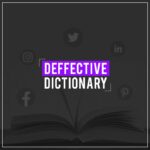In the 1920s, the most prevalent advertisement on the face of this planet were radio jingles played in one-minute spots for $100. A hundred years and exponential evolution in the field of advertising later, we’re here- in the era of digital advertising! Raking up 153 minutes a day on average, 3.6 billion people currently use digital platforms. It is no surprise that this number is only projected to rise every year.
This blog is a little guide that will take you through the most essential terms in digital advertising that will help you get that huge number of people.
Social Media Marketing
Social media are accessed by almost half of the global populace. One would no doubt, want to advertise to them. Social media understands that absolutely anything on it is invaluable and profitable. And that is the reason why so many social media advertising tools exist today.
Social media marketing uses social media platforms to advertise and improve brand image, boost sales, and gain more website traffic. For the best results, material posted on social media has to be top-notch content that users find worthy of sharing with their network. Brands run advertisements, publish high-quality content on all social media profiles, and interact with their followers. The entire framework is extremely flexible: any advertising budget can find a purpose here. A small local coffee shop to McDonald’s, a business of any size can advertise on social media.
Facebook Ads Manager
Regardless of where you choose to advertise, you would want to see how your campaign is performing, right? That is where a tool like Facebook Ad Manager comes in. It is Facebook Inc.’s free marketing tool to create, run and manage advertisements on its various platforms. It is possible to use the Ads Manager to run advertisements on Facebook, Instagram and Messenger. The user-friendly tool is very easy to set up and comes with a defined set of objectives to help categorise and track all your campaigns. With the amount of data available, one can monitor performance metrics engagement and reach. Apart from just seeing results, you can also look for opportunities to improve future advertisements.
Objectives
It is essential to consider what your goals are before creating an advertisement on a tool like Facebook Ads Manager. This helps to set clear objectives for your ad campaign. An objective is an action that you want people to do when they see one of your advertisements. It can impact what activities you optimise for, what you pay for and even what types of creative options are available to you. Once the objectives are input on Ads Manager, Facebook analyses its userbase and shows your advertisement to a set of audiences who are more likely to perform the desired action.
As time passes and a business grows, the objectives are bound to change. A new company may focus on increasing awareness about themselves and get their first customers. Later they may focus on reminding people about the brand and getting people to sign up for newsletters.
Boosted Post
A boosted post is promoting a pre-existing post on a business’ page. This helps amplify the reach of a post. Boosting a post exposes it to new audiences who might like, share or interact with your brand.
When choosing a post to boost, brands often go for ones that feature their most popular products or ones that already had a high engagement. Although the options while boosting a post are lesser than a Facebook ad, boosting a post is easier and often is the most effective way to increase interaction on the page.
Once a post is live, a small blue ‘boost post’ button appears on its bottom right. Clicking it will lead you to a page where you can select your audience, budget, duration, and other objectives and send a request to Facebook for review. After a team from Facebook approves it, you’re all set to go!
Search Engine Marketing
So, here’s the deal. The listings on the first page of any search result end up stealing 71% of the clicks. And the top three listings take 50% of them. Of course, a brand would try their best to appear among the top results.
All tactics used to improve a website’s visibility among the results on any search engine fall under Search Engine Marketing. This can be done organically through Search Engine Optimisation or be paid to appear on top, in which case, they appear as text advertisements. Conversions, sales, traffic, ROI, you name it, SEM can do it for you.
Calls to Action (CTAs)
Read this blog till the end to unlock the secrets of the universe!
Aah! If only a Call to Action on a blog about digital advertising could do the trick!
Call to Action is a prompt on an advertisement or any marketing material to make a user do a specific action. And they are very important to take a user from one stage of buying to the next.
But every time a user sees a call to action, their first response is ‘so what?’ A good call to action bypasses this sarcastic doubt with clear communication. They are normally short, powerful copies with a definite intention. A car would definitely click on an advertisement that says “Last day to test drive the Seltos SUV in your city. Call now!” This line taps into the person’s FOMO and compels them to at least check out the form or webpage on the other end of the button.
Conversion rate (CVR):
During a campaign, you must decide upon goals or desired actions that you want the audiences to do. A Conversion rate is simply a measurement of how good your digital advertising campaign is at achieving those goals. It is a percentage of visitors to your website that do what you want them to do. It is written as the ratio between the converted audience and the total audience. And to express as a percentage, the ratio is then multiplied by 100. Here’s the formulaic representation:
Conversion rate = (conversions / total visitors) * 100%
A reasonable conversion rate is the culmination of a great campaign, great advertisements, good SEM, calls to action and everything else in this blog!
Retargeting
Imagine if all the people who visited your website left with a purchase. Your marketing team could take a week-long vacation. But sadly, it is only less than 8% of the total visitors who make a purchase. Retargeting helps remind almost 92% of visitors about your product as they would be surfing the net, using their social media or catching up on the news, or looking at your competitors’ sites. Remember all those cookies on your phone you get every time you visit a new website? Those usually used to profile ‘window shoppers’ who have once seen your advertisement are targeted to see them again. This is a highly effective tactic that guarantees a better conversion rate than before the retargeted users have already shown interest in your brand.
Here’s a teensy checklist you can use for your future social media marketing campaigns:
Set goals – Build a strategy around it – Fix a budget – Decide on the platforms – Create great advertisements – Hit the publish button.
And that’s it! You’re wiser than five minutes ago! The opportunities to promote your brand online are endless. Now that you know about the most essential digital advertising elements, it’s time to implement them in your next marketing strategy.
Showtime!
-
Content that rocks the world
06 November, 2020 -
Design: Bringing Ideas to Life
12 November, 2020 -
Whassup Bud: One of Budweisers’ Evergreen Television Ad Campaign
20 November, 2020 -
Brands must be Gods
27 November, 2020 -
The Deffective Dictionary
08 January, 2021






